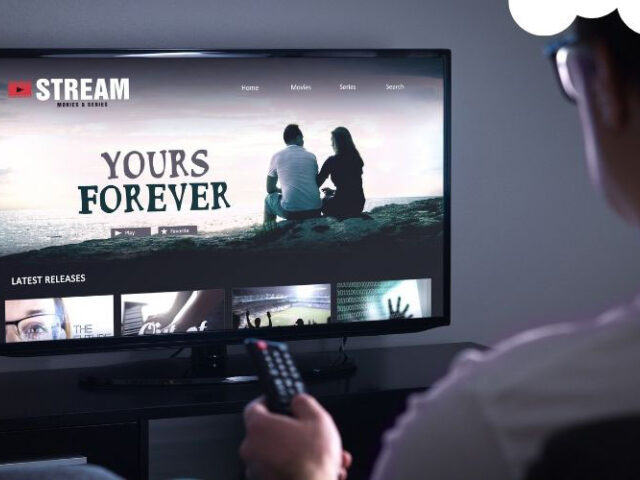Media Trends | Feb 22, 2022
Zero tolerance for buffers - How video streaming makes users happy

What do video streaming provider have to offer to be attractive for users and which obstacles are often overlooked? Sebastian Siepe and Ralf Neudel know the pitfalls of streaming. With their startup, they are creating solutions that make users actually enjoy media libraries and streaming services instead of being frustrated by them.
Table of Contents
- Streaming is an attractive minefield
- Why is streaming so popular?
- Why is streaming so popular?
- Will TV streaming replace linear television?
- Will TV streaming replace linear television?
- Can linear TV stations still afford not to have a streaming offering?
- What can small and regional stations do to get a foothold in the streaming market?
- How much budget is necessary for your own streaming offer?
- With einbliq.io, you focus on the technological aspects of streaming. What are the pitfalls when media companies want to launch a streaming service?
- With einbliq.io, you focus on the technological aspects of streaming. What are the pitfalls when media companies want to launch a streaming service?
- What should a streaming platform offer to make you a subscriber?
- There are about six or seven major providers of video streaming on the German market. Classically in entertainment and also in sports. Is there a demand for such a large selection?
Streaming is an attractive minefield
About 29% of Germans use a video streaming service once a week. These include the well-known players such as Netflix, Amazon Prime and Disney+, as well as the media libraries of TV broadcasters. Streaming has clearly established itself and is a permanent fixture in households. For Netflix, publicly available user data is readily available: For example, one in four Netflix users is between 20 and 29 years old. Overall, the outlook for streaming providers looks promising. In SVOD (streaming video-on-demand) alone, revenues of EUR 2,214 million are estimated for this year.
German TV broadcasters are also moving in the direction of streaming in order to generate new sources of revenue. As early as 2020, the media group RTL published a study that foreshadowed video streaming will also play a major role for the economy of TV stations in the future. It states, among other things: "Paid SVOD offers reach broad and socio-demographically diversified target audiences. Streaming offers from German TV station groups provide an optimal product and brand fit for these target audiences."
But what do TV broadcasters need to keep up with streaming and what factors should be considered? The two media technology specialists Sebastian Siepe and Ralf Neudel are intensively exploring streaming. In 2020, they founded the startup einbliq.io, which helps providers to operate streaming services more reliably and cost-effectively. This is because the two founders have also recognized that many providers are struggling with the unending number of devices and platforms, while distribution costs continue to grow. At the same time, competition among streaming providers and the struggle for market share is intensifying.
Why is streaming so popular?
Why is streaming so popular?
Ralf: The use of streaming services has long since reached the masses - even across age groups. In our experience, usage remains very diverse. In other words, many younger people use streaming anytime and anywhere - they often don't even own a conventional television set. At the same time, access to streaming services has become increasingly easy - especially on the big screen television in the living room. And that's where we're seeing particularly high growth rates, because more and more "non-digital natives" are now able to enjoy the benefits of streaming directly: a massive selection of content is available at all times.
Of course, streaming itself has also become increasingly attractive for users thanks to market players such as Netflix and Amazon Prime. These large international companies invest large sums in their original productions and can monetize this content far more easily on a global scale than smaller national TV broadcasters could.
Will TV streaming replace linear television?
Will TV streaming replace linear television?
Ralf: There are actually two questions here - let's first look at what linear television means for users in the respective context: There is content (such as sporting events) that is and remains mainly of relevance in a live context - this was and is a classic case for linear television - even if streaming providers such as DAZN are now also pushing into this segment. At the other end, there is "timeless" content, or content that could be interesting "at any time". Here, linear television plays more of a curation role - a television editorial team decides which content should be presented to its viewers in which context. This sometimes works better and sometimes not so well. At the same time, of course, you can also do both with streaming services - and with significantly more ways to specifically address smaller target audiences. And then there's the whole area in between from a consumer point of view - current content, but not live/event content - that works in classic lean-back TV, but also works well for self-selection...
Sebastian: All the scenarios of linear TV outlined by Ralf can of course already be realized very well with streaming technologies today - at least everywhere a suitable Internet connection is available. No doubt, distribution via the Internet is more flexible, because it can cover the entire spectrum from simultaneous, slightly time-delayed to completely time independent. But, technologically, there are still wildcards and as a provider I never know how well and stable the service will be on the users' end. Very large sporting events, such as the World Cup or the Olympics, continue to confront providers with major technological challenges. The risk of something going wrong is very real, and the resulting damage is immense - something that everyone who provides livestreaming for major events has had to experience. And there are other aspects: When broadcasting via cable, satellite and antenna, additional viewers do not cause any additional costs. This is different with streaming: Each user requires additional bandwidth and energy - resulting in additional costs.
Can linear TV stations still afford not to have a streaming offering?
Ralf: Probably not. I also don't know of any TV station that doesn't at least try to distribute its linear content as on-demand content as well. Ultimately, though, the change is a bigger one. How do content and services change when streaming takes center stage? We're witnessing these discussions everywhere, e.g. ARD has been focusing more on documentary long-form formats since this year. Because those perform better in the media libraries than magazine features do. There is no one-fits-all for linear, media library and the very distinct social media channels.
Everything is certainly also a question of presentation and the platform in which the content is offered. On third-party platforms such as YouTube, however, shorter contributions in particular are very relevant - perhaps this will also become true for the own services in the future? Basically, I expect even greater editorial shakeups overall. How do you customize content for different platforms when streaming is becoming more and more central?
What can small and regional stations do to get a foothold in the streaming market?
Sebastian: That's a huge challenge. Even larger providers can hardly afford to create their own offerings for all devices and platforms and attract a critical amount of users. That's why I would recommend starting with an offering on the web and on the TV via HbbTV. With both, you get direct access to the users with standardized technologies and no gatekeepers. After all, it is much less likely that you will be searched for and found in app stores. Partnerships or collaboration with aggregators offer more attractive approaches. ViacomCBS, for example, cooperates with the german platform joyn. But a solution like vewd, which combines content from several providers for different SmartTVs, can also help to tap into new markets.
How much budget is necessary for your own streaming offer?
Sebastian: That is impossible to say in general terms and depends on many of the factors just mentioned and, of course, on the type of content. There are good white-label solutions and different service providers to use for this, but visibility in the market won't increase on its own.
Ralf: If a TV station today practically invests everything in the production and distribution of a linear program and only sees streaming as a supplementary service, it will be very difficult to succeed in the long term. I think everyone gets that today - but it's still difficult to adapt the strategy. But even as a new, pure streaming provider, it will be extremely difficult in the current environment. The number of subscriptions that users will want to pay long-term will remain very limited, especially in the German market. Even the big players like Netflix are realizing this, and are trying to compensate for the lack of growth with higher subscription prices - but even that has its limits, of course. Therefore, again, the market will tend to consolidate and partnerships will continue to grow in importance.
With einbliq.io, you focus on the technological aspects of streaming. What are the pitfalls when media companies want to launch a streaming service?
With einbliq.io, you focus on the technological aspects of streaming. What are the pitfalls when media companies want to launch a streaming service?
Sebastian: Apart from the strategic and economic issues, there are a number of technological ones. The various platforms and devices, including TV appliances, are growing in number and all have their own technological quirks. As a provider, you end up streaming into the dark and you really won't know what will end up in the user's living room, it might be laggy, buffering or interrupted. You'll often find out about it through bad reviews in the app stores, but you can't pinpoint the causes.
There are countless typical sources of error, such as encoding or packaging - i.e. the way the video content is distributed. Sometimes, however, there are also problems with the interaction of the specific Internet provider at home (ISP - Internet Service Provider) or with the service provider through which a TV station delivers its content (CDN - Content Delivery Network). Or simply, the content cannot be accessed in the content management system at the provided address - all this happens again and again. As a provider of often tens of thousands of videos, you can't keep track of everything, and you shouldn't exhaust your valuable developers with tedious manual troubleshooting. This is where our services come in. Errors like these should be detected and corrected as automatically as possible, so that they won't happen again in the future. After all, if users have frequent issues with streaming, they'll be gone, and that's why we're helping to precisely avoid problems like these.
The other factor to consider is the rising cost of streaming for providers. We have tested how streaming providers can easily add capacity from other (often cheaper) providers without having to change anything in the existing workflow.
What should a streaming platform offer to make you a subscriber?
Ralf: Attractive content is certainly the main argument to win me over. Of course, individual interests and preferences are often the deciding factors, and it's not just about quantity (who can keep track of that anymore...). And of course it has to be easy and affordable. I also switch providers from time to time.
Ralf: Likewise the choice of content. But also technical problems have driven me away from a provider before. I like to use Chromecast to find content on my phone and then watch it on the TV - at some point it just didn't work properly anymore, it always crashed. That was really annoying. Of course, I didn't send an error report.
There are about six or seven major providers of video streaming on the German market. Classically in entertainment and also in sports. Is there a demand for such a large selection?
Sebastian: From the user's point of view, I find the increasing number of providers rather unattractive - six to seven is a rather conservative estimate, and the number keeps growing. Unlike music, you would need many subscriptions to be able to stream all content. I'm interested in the content, not so much the provider. I think that leads to the switching Ralf mentioned - which is difficult to calculate for the providers and economically highly risky. It's different, of course, if you can build a real brand as a streaming service that creates trust in the content selection, or you can score points with certain target audiences. DAZN for sports, Disney+ for family content, or even small providers like MUBI for indie films immediately come to mind.
Ralf: I do expect movement among the providers - but the different national laws complicate things a lot, even for an international provider like HBO, who is currently pushing into the German market. On the other hand, the market is becoming saturated - the providers are in a dilemma: They need (original) exclusive content that is expensive to produce or buy, but then they can no longer license as much, and at the same time the market is simply finite.
We will see attempts to bind customers more closely, e.g., by bundling with ISP contracts or when content providers supply the television set, as we are already seeing in the UK with Sky Glass.
Ultimately, however, this will make matters more and more complex, requiring many bilateral contracts and cooperations. Smaller providers will often find it difficult to cover all the different platforms - not all of them will survive this progressive fragmentation of the market.
For the European media industry, I see two providers in particular that are likely to expand their current dominance on the Internet into the media sphere: Amazon is already a successful content provider, has many subscriptions through bundling with Prime, and at the same time is flooding the market with extremely cheap FireTV sticks, which represent the TV home screen in more and more households. And Google should not be underestimated either, TV manufacturers like Sony and Philips already use Google TV as their interface, at the same time Google offers the seamless user experience via Android smartphone and the Chrome browser including integration with YouTube. Google will certainly try to position itself as a powerful content aggregator. And usability ultimately plays a big role for consumers in where they end up or stay.
Sebastian: But we also see another very important point for the near future: There is a majority of studies that already address the energy consumption caused by streaming. Even if you can argue about calculation methods, media use via the Internet already plays a clearly measurable part in global CO₂ emissions. We have some ideas on how to reduce energy consumption based on data and thus making streaming more sustainable.


